1er
BEP, "Operation Douarnenez"
August 1953
Rolling
Thunder French Indochina war
studies for re-enactors
The
Indochina Living
History small section of Rolling
Thunder have done an improvised
photo shoot
at War & Peace Revival 2018
to write a second uniform study
on the 1er BEP, this time in mid
1953.
The
French paratroopers in Indochina
were the post-WWII elite forces
of the French army. They were
used as firemen for the
Indochinese theatre and wherever
a situation needed sorting out, they
were engaged.
As Elite troops,
their uniform was always quite
distinctive from the other
French troops and evolved
quickly
during the war.
|
Rolling
Thunder, the
Vietnam
Experience
gives you the
full Vietnam
experience by
bringing
you
the 1st
Indochina
war.
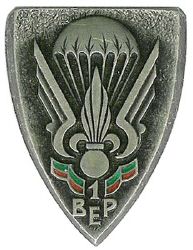
1er
Bataillon
Etranger de
Parachutistes,
1er BEP
1er
BEP was
created on 1
July 1948 in
Algeria,
arrived in
Indochina on
the 12
November
1948
and fought
mainly in the
Tonkin region
(North
Vietnam).
Setting
the scene
The
1er BEP, was
airlifted from "Seno air base"
in Laos to
Tourane
(Da Nang) in Cochinchina
on the 2-3 of
August 1953
to start a search and
destroy
operation, north
of Nha
Trang near Tan
Xuan and QL26.
15/08 Operation
Concarneau,
search and
destroy south of
Tan Xuan
16/08 Operation Douarnenez,
search and
destroy north of
Tan Xuan
Original
photo which inspired our
photoshoot
Two Legionnaire from the 1er BEP photographed
during operation
"Douarnenez
"
info thanks to
"la Legion Étrangère
en Indochine
1946-1956 book,
photo from the
internet.
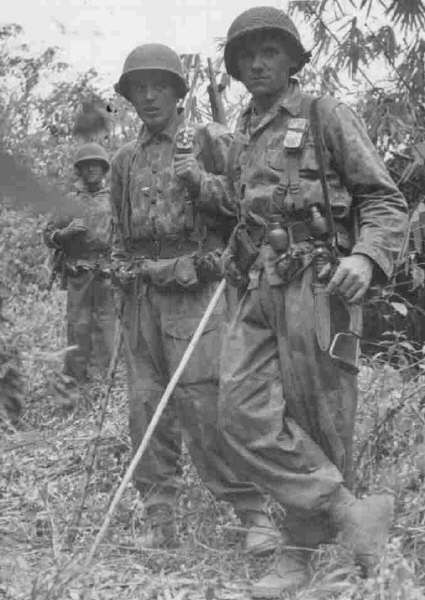
The
man on the left
is wearing a
USMC M44 jacket
while the one on
the right is
wearing the Army
M43 version.
Below,
recreated
photos by
members of
Rolling Thunder,
Indochina
section and
photographed by
Sean Vatcher.
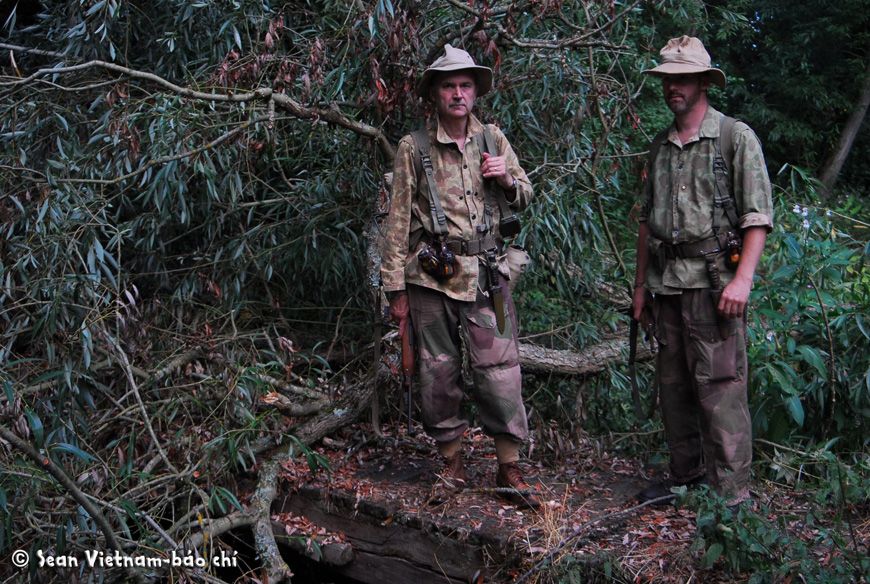
The
mixture of
British
Windproof
trousers with US
Camo HBT jacket
will be a characteristic
feature
of the French
Para during the
period of 1951
-1954
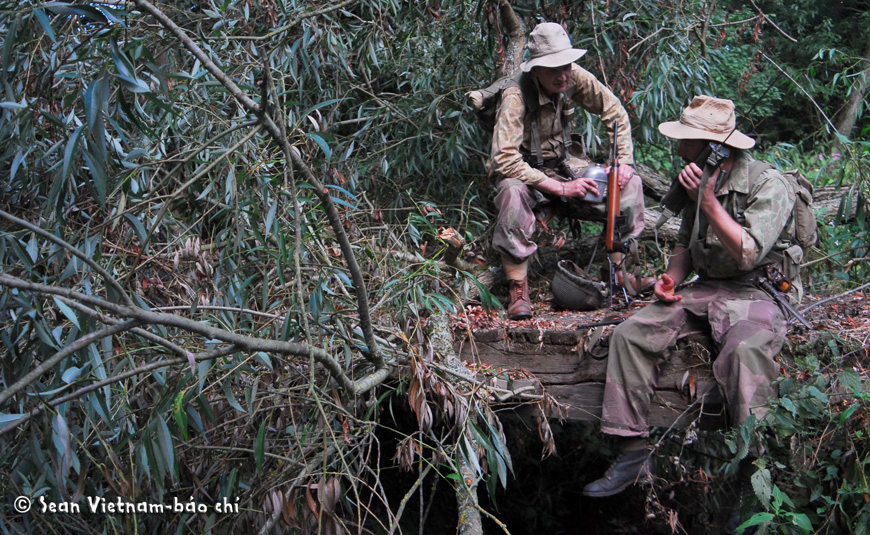
|
***
This
uniform study is of the 1st Foreign Legion paratrooper
battalion,
Uniform
& Equipment description
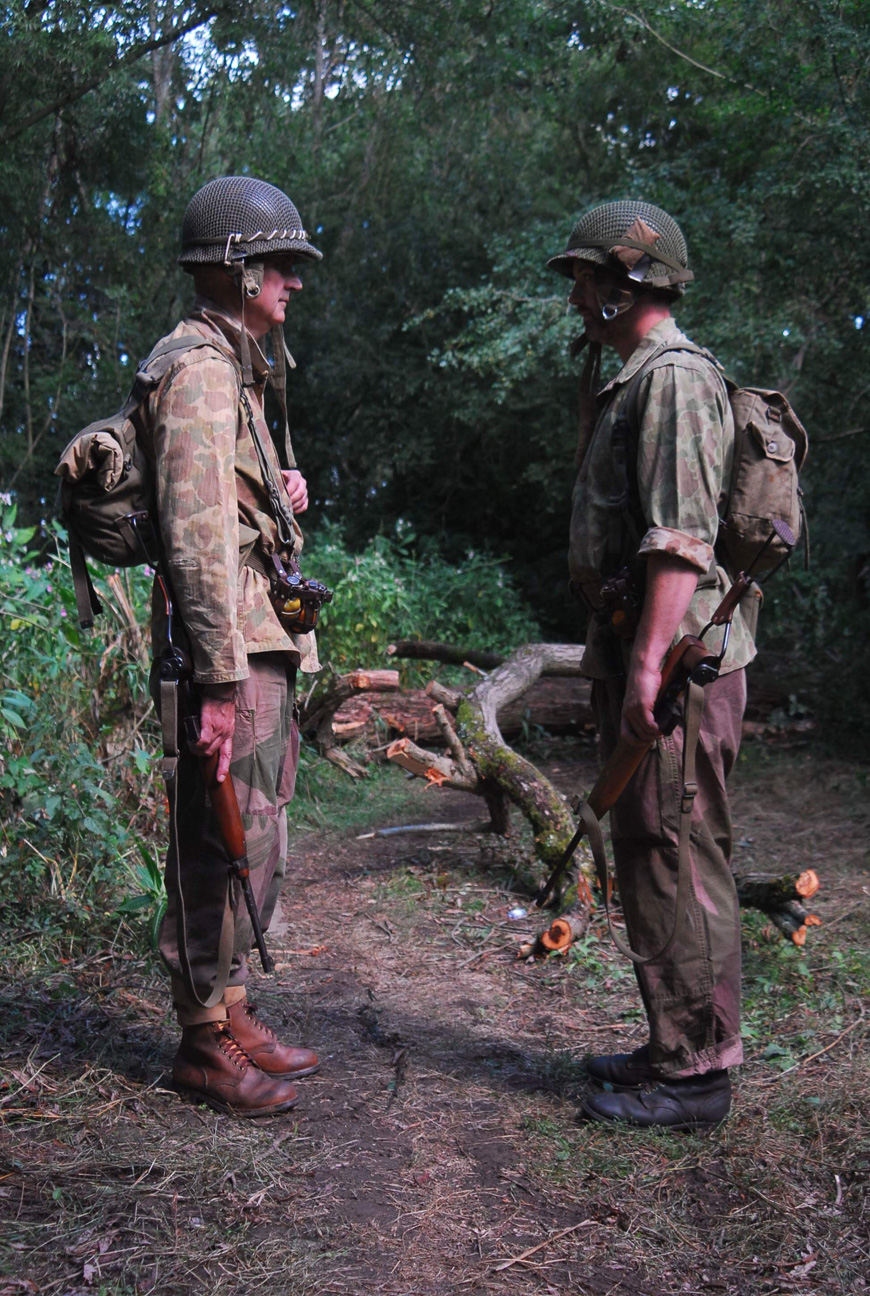
Both
French Para in the photo are
wearing very similar uniforms
and equipments
The
man on the left is equiped with
a M1 helmet which has received
the TAP-EO modification
and is covered with the US-M44
camo net, he is wearing a USMC P44
camo jacket with British Windproof
trousers. British M37 gaiters and
new Brodequin M52 ankle boots (rare in
Indochina), his equipment
is mostly French TAP with the
exception of two M1 carbine US
ammo pouches, his haversack is the
TAP Musette M50, he is armed
with an folding stock M1A1 carbine, late war
production with bayonet lug, a
couple of theater made grenade
pouches with OF & DF
37 grenades and US M3 fighting
knife. He carry a US M44 water
bottle, a French M35 quarter
shelter tent can been seen in
his TAP50 haversack. To be noted
is the
Carlisle metal First-Aid pouch
held by an elastic band to his
suspenders. They were mainly
seen in the helmet band or under the
camo net. He carry a
WWII US BC-611 radio
(SCR-536)
Our
second paratrooper on the
right virtually wear the
same uniform and equipment that
the first man. Only difference
is the French M51 water bottle,
a M41 or M45 brodequin (ankle boots) which
can be identified via its reinforcement
rivet on the side. He is armed
with the early M1A1 Carbine, no bayonet
lug and TAP M51 musette
identifiable by the button on
the small side pocket instead of
the popper.
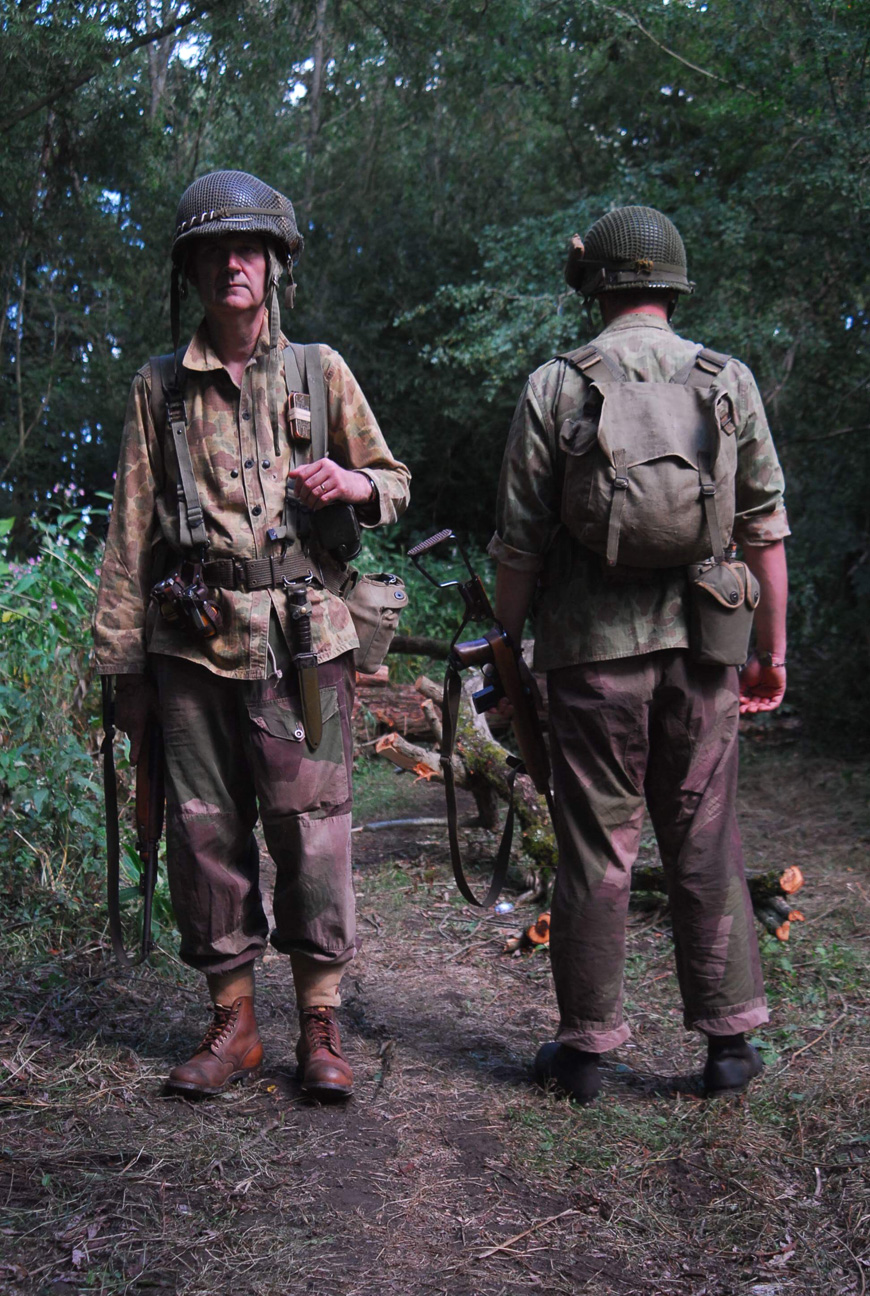
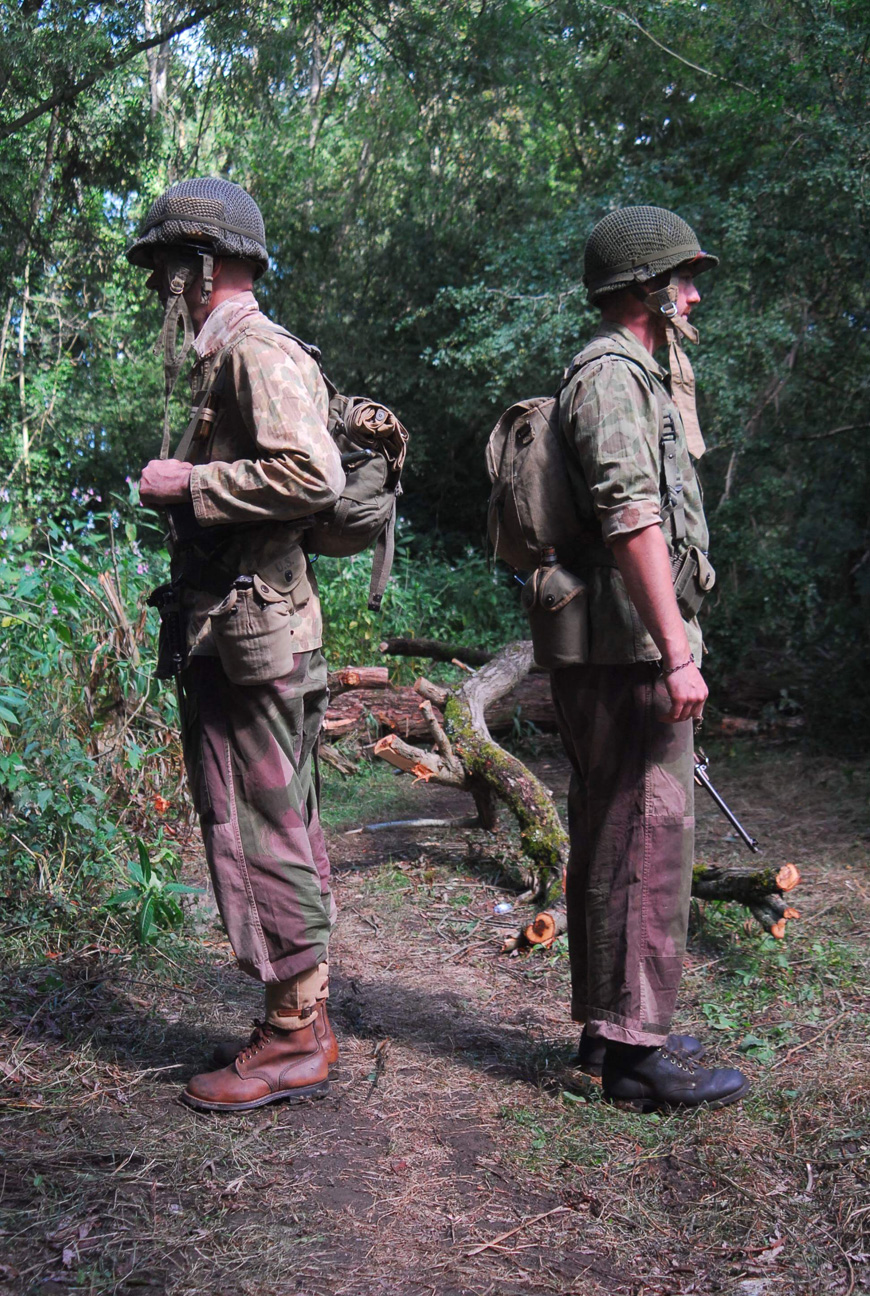
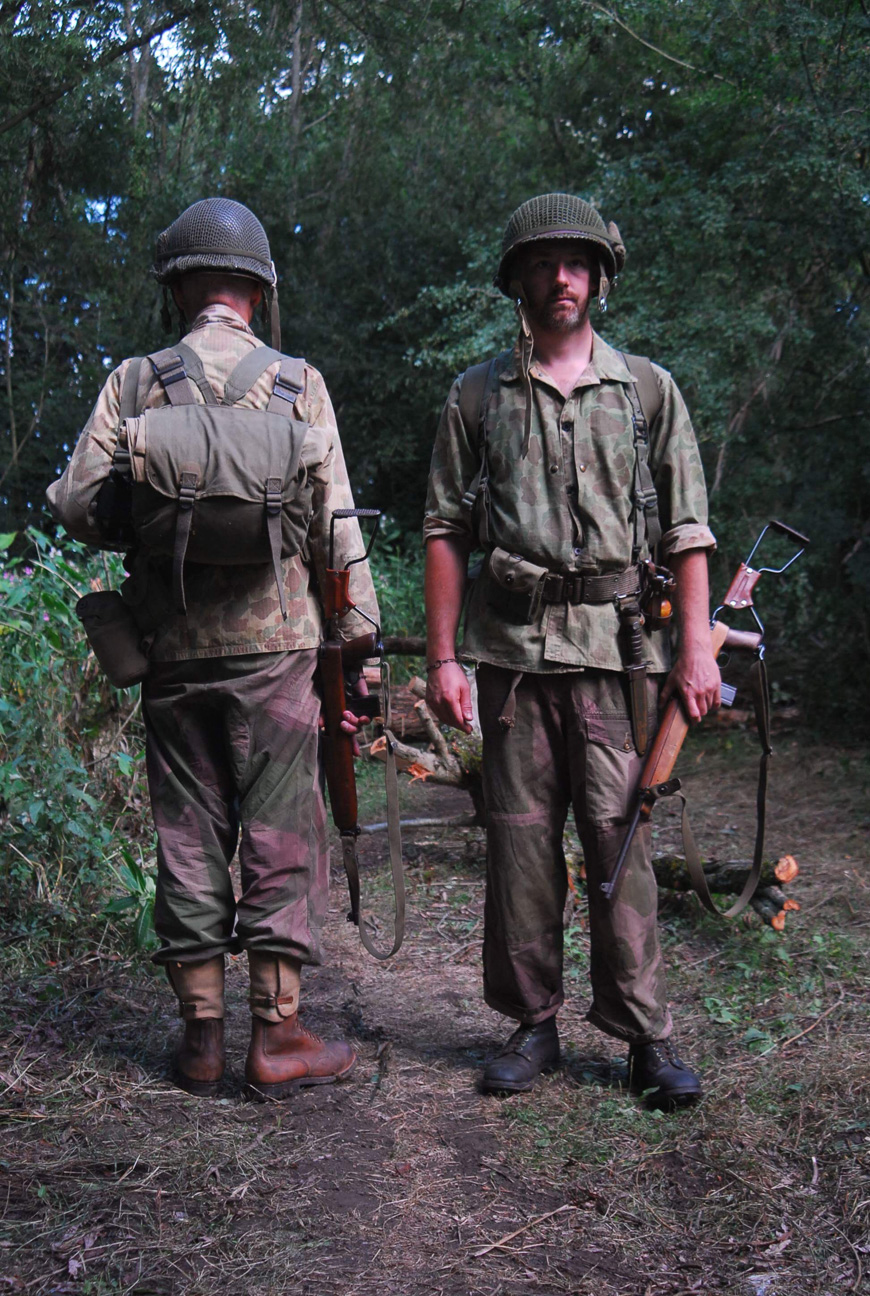
Detailed
description
Helmet
_tm.jpg)
The French Para helmet was
WWII US M1c or the M1 with a
modified liner which had received the TAP/EO Airborne
Indochina modification.
The camo
net was the US WWII
M43 net with its
foliage band. On the photo
above, the band holds a US
WWII Carlisle dressing which was
much preferred due to water
resistance.
The white
cord looped around the foliage
band is a piece of parachute
suspension cord which was used
to secure the helmet
to the webbing during
parachute jumps.
In fact the
TAP/EO modification were not
that strong as made of
standard cotton cloth and
not webbing so, unfortunately
they sometimes broke
during parachute jumps resulting
with the loss of the
helmet. With the cord, the helmet would
stay suspended to the webbing
to be retrieved once on the
ground.
_tm.jpg)
Re-enactors
notes: genuine war time TAP/EO converted
helmets are extremely rare and command very high
prices. Conversion kits and converted
post war M1 helmets are available
from specialised dealers.
Genuine nets are a little more
difficult to obtain but repro
are available. Genuine
First-aid bandage are very common.
Uniform
_tm.jpg)
US
WWII, USMC P44 camo jacket
.
The USMC P44 had an
early late construction, with
some design improvements on
the later Coat which consist of
horizontal buttonholes and the
male pouch snaps being
reinforced by heavy web tape
rather than HBT cloth. Also they
had a greener tint.
Re-enactors
notes: Expensive item,: repro do
exist, but do be careful as the
P42 is sometime listed as a
P44
by some internet sellers
_tm.jpg)
WWII
British Windproof trousers
The windproof came in a
two-piece suit: smock and trousers,
the Windproof Camouflaged Smock was
intended to be worn as an oversuit
over the Battledress. The pattern of
printed camouflage was unique to
this form of dress and it became
popular with the Special Air Service
and various commando units.
It is sometime referred as SAS smock
by collectors. This was know to
the French army as "peau de
saucisson" "sausage
skin" due to it's feel. They
were used as issued or received
modifications: the
trousers were sometime remodeled
with a Zip or button fly and pockets
were some time added or moved.
Re-enactors
notes: Genuine British War time
Windproofs are commanding high price
now, luckily fairly good
reproductions have been
available for re-enactors and even
collectors.
As far as I am aware, there is 3
manufacturers of them, Panzerfaust,
What Price Glory and Silverman, the
last one been a poor replica due to
the wrong colour print and heavy
material used.
Equipment:
_tm.jpg)  copy_tm.jpg) 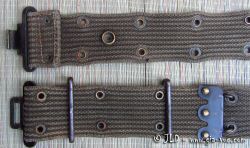
At
that time the 1st BEP was mainly
equipped with the new TAP 50 French made
equipment with
some left over from earlier
time, ie British and US
equipment.
On the photo above
is a typical set up for a Para rifleman, TAP 50 suspenders
with a TAP 50 belt, WWII US M1
carbine ammo pouch
with either
the French TTA
M51 water bottle
or the US M10/M44 water bottle.
Re-enactors
notes:
The M50 belt is the one to get,
but is rare.
From the late 50's some M50
belts were manufactured in
Europe for
"Regimental
foyer" which can be
recognised
by the flat metal belt
loop instead of the rounded
type used on the original
Army issue belt. They are a lot
less desirable.
Buyers must be aware that fake
M50 belts have been made from
the French M50/53 belt webbing
with 50's
British web belt buckle
and with the flat belt loop.
The M36 US WWII web belt would
still have been common with the
1er BEP.
The rest of the equipment can be
easily obtained via the
internet, except for the TAP musette
which is rarer,
but can be
substituted for a WWII US Para
repro one. A genuine M3
knives are expensive, but good repros do exist
_tm.jpg)
TTA51 water bottle, cup and pouch
Re-enactors
notes: a second and later model
of the pouch was made with the standard poppers, these were issued
after the Indochina war and are not correct.
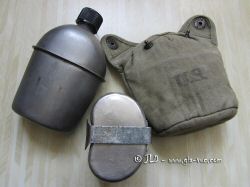
US
M44 canteen with pouch and
cup, the M1910 with the
metal cap was also used
Re-enactors: These are still plentiful and easy to get so no need
for repro
_tm.jpg)
M3 Fighting knife
The fighting knife was
often carried by the French on
the front of their belt as seen
in the photo above.
_tm.jpg) _tm.jpg)
US WWII M1 carbine, twin mag
pouch
on the left is the first model with the second model on the right
Both have the French
conversion to allow the TAP harness to be attached to them
Re-enactors: still
affordable
or you can use non modified WWII ones, all WWII US equipment is
still available,
so do not use repro, as they are not of very good quality and can be
easily spotted!
_tm.jpg) _tm.jpg) _tm.jpg) _tm.jpg)
TAP 50 musette/haversack,
this is the first version with a
poppers, the M51 will have
buttons instead
Re-enactors:
Original are expensive
and
rare.
_tm.jpg)
French M35 light khaki Tent shelter-half
the US M42 model with front and rear flaps was favoured
when available
_tm.jpg)
Re-enactors:
Original are still
can be obtained at a affordable price.
_tm.jpg)
US
WWII Carlisle 1st Aid dressing
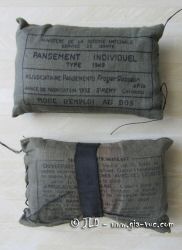
fM49
French 1st Aid
dressing, bottom one with a
piece of inner tube around
it.
Re-enactors:
both are still easy to get
and cheap.
Boots
_tm.jpg)
_tm.jpg)
Footwear was quite
diverse around 1953, and it was very common to see French paras
wearing the Infantry ankle boot with gaiters, (This ranged
from the WWI M17 to the WWII M41/M45 Brodequin. Only a few of the
M52 model were sent to Indochina for field evaluation).
All the brodequin were in natural leather colour, but soon turn to
dark brown then to near black due to heavy application of shoes "graisse"
dubbing to keep them in a serviceable condition in the harsh
and damp conditions of Indochina. The two separate M52
brodequin showed in the photos
illustrate the darkening process. The inset is of the M45, reinforcement
rivet.
Re-enactors: the
brodequin do vary in prices and you can sometime get original M41/45
for sensible money,
the M52 can also be converted with the addition of a small rivet on
the side. Beware, I have seen some "cut off" French issue
"brown M50 rangers
boots" sold as
brodequin. NOTE: the
TTA M1950 Ranger boot was
not issued in Indochina!
_tm.jpg)
One of the gaiters
often used by the Para is the British WWII M37,
here with the leather straps, some were made with canvas straps
Re-enactors:
Original are still around and still affordable.
_tm.jpg)
The
weapon
Above the US M1A1 carbine,
characteristic weapons of the Indochina French Paratroopers,
this one is the later model with the bayonet lug and is the airborne
model with folding stock.. The
M1A1 carbine was well liked by the Para for it compactness and
lightness, more ammunitions could also be carried, but the 30
Carbine caliber with its 1990 fps muzzle velocity lacked a
little in punch and penetration specially in jungle environment.
Re-enactors: Original are expensive but
good repro can be obtained.
_tm.jpg)
Another characteristic weapon of
the French Para is the US WWII M3 fighting knife
Re-enactors:
Original are expensive
but good repro can be obtained
_tm.jpg)
French DF37 and OF37
grenades.
Re-enactors
OF/DF37 are
rare and difficult to obtain
here in the UK, but are
available in resin form from
France
_tm.jpg)
The
radio
WWII US BC-611 radio
(SCR-536) with a
range of
1-3 miles, the lesser for
Indochina terrain.
Re-enactors notes: rare radio to
obtain.
More
photos of photoshoot at War
and Peace Revival 2018
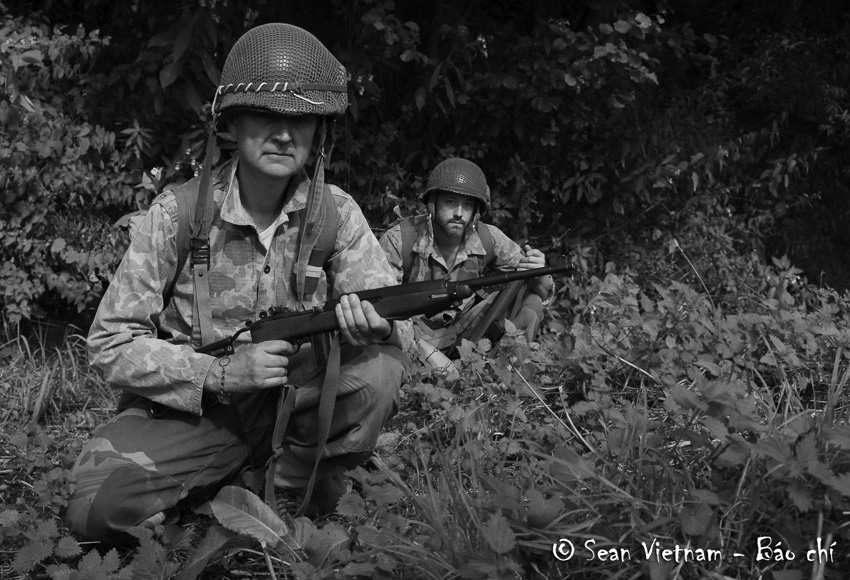
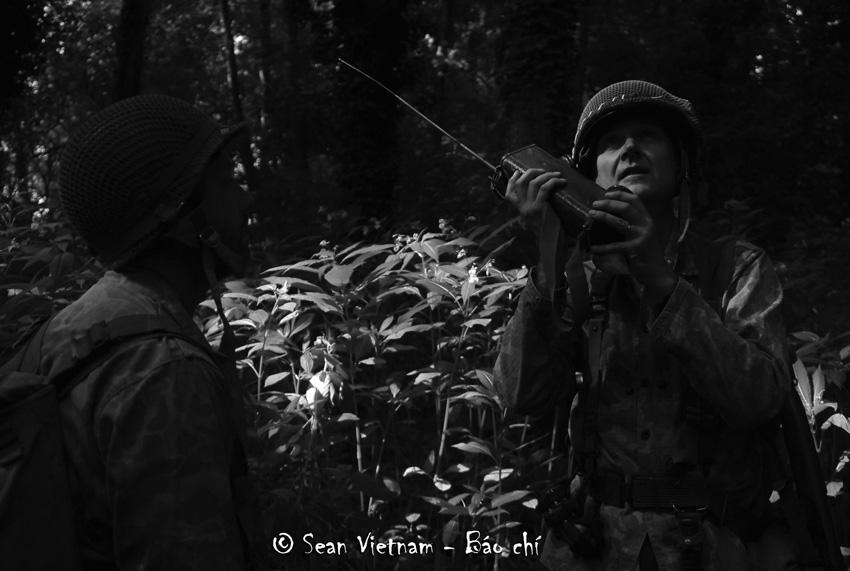
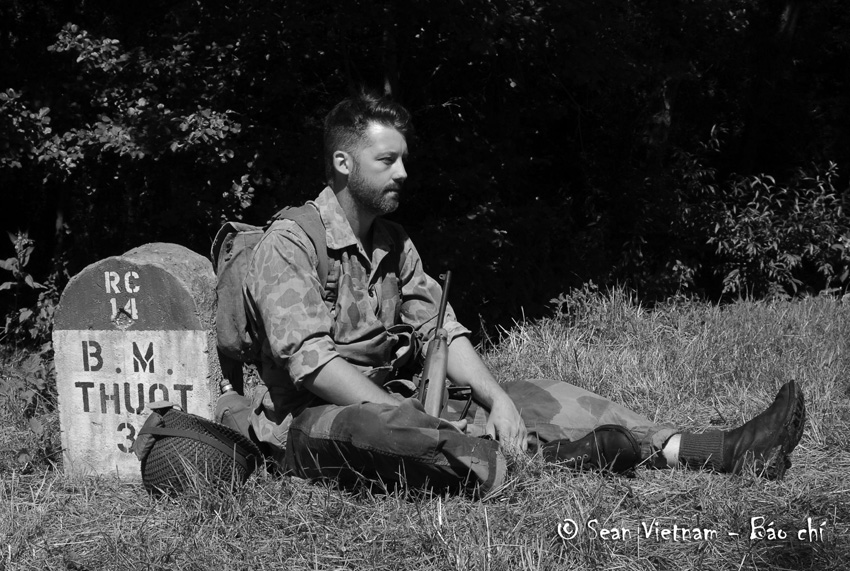
Please
note the equipment and uniforms
described here are time specific for
the 1st BEP.
For
instance,
they would have worn different uniforms and equipment
during
the RC4 fighting in 1950 or DBP in 1954.
***
Here is the list of our requirements
for that specific photoshoot.
Helmet
US M1C or M1 modified TAP
US
1943 pattern camo net with or
without band
USMC
P44 camo jacket
WWII
British Windproof trousers
British
M37 Gaiters
French
Brodequin M17/41/45/50/52
(Note, the M52 was not
issued in Indochina but a small
quantity were send for
evaluation)
M50
TAP belt
M50
suspenders
French
M51 or US WWII M1910 or M44
water bottle
M1 carbine
with folding stock with US M1 twin cell
pouch ammo pouch.
TAP
M50 or M51 musette bag
M35
light khaki square tent/poncho
French
or US WWII Carlisle or British
WWII field dressing
M3
fighting knife
OF
or DF French grenade
SRC536 radio
***
|